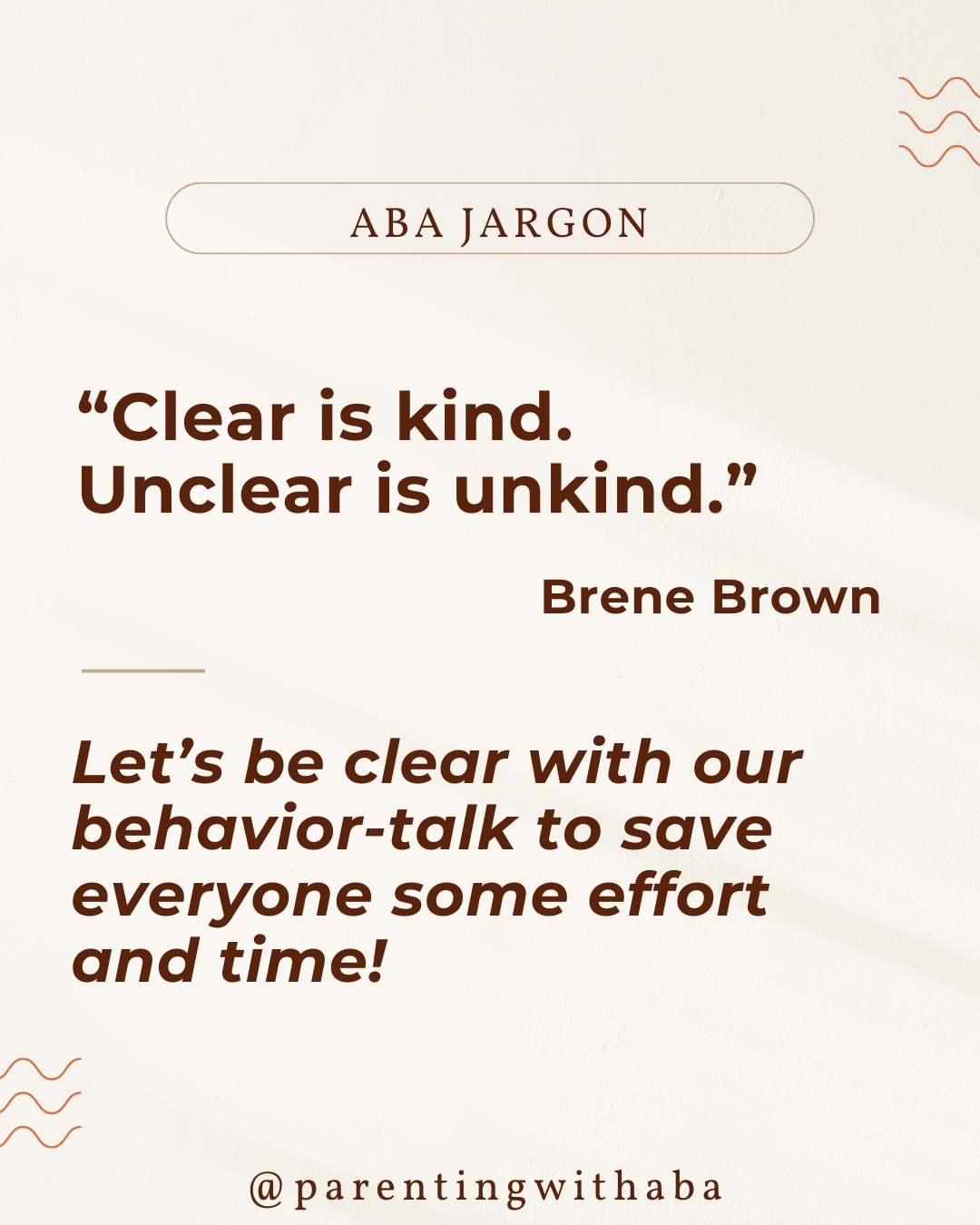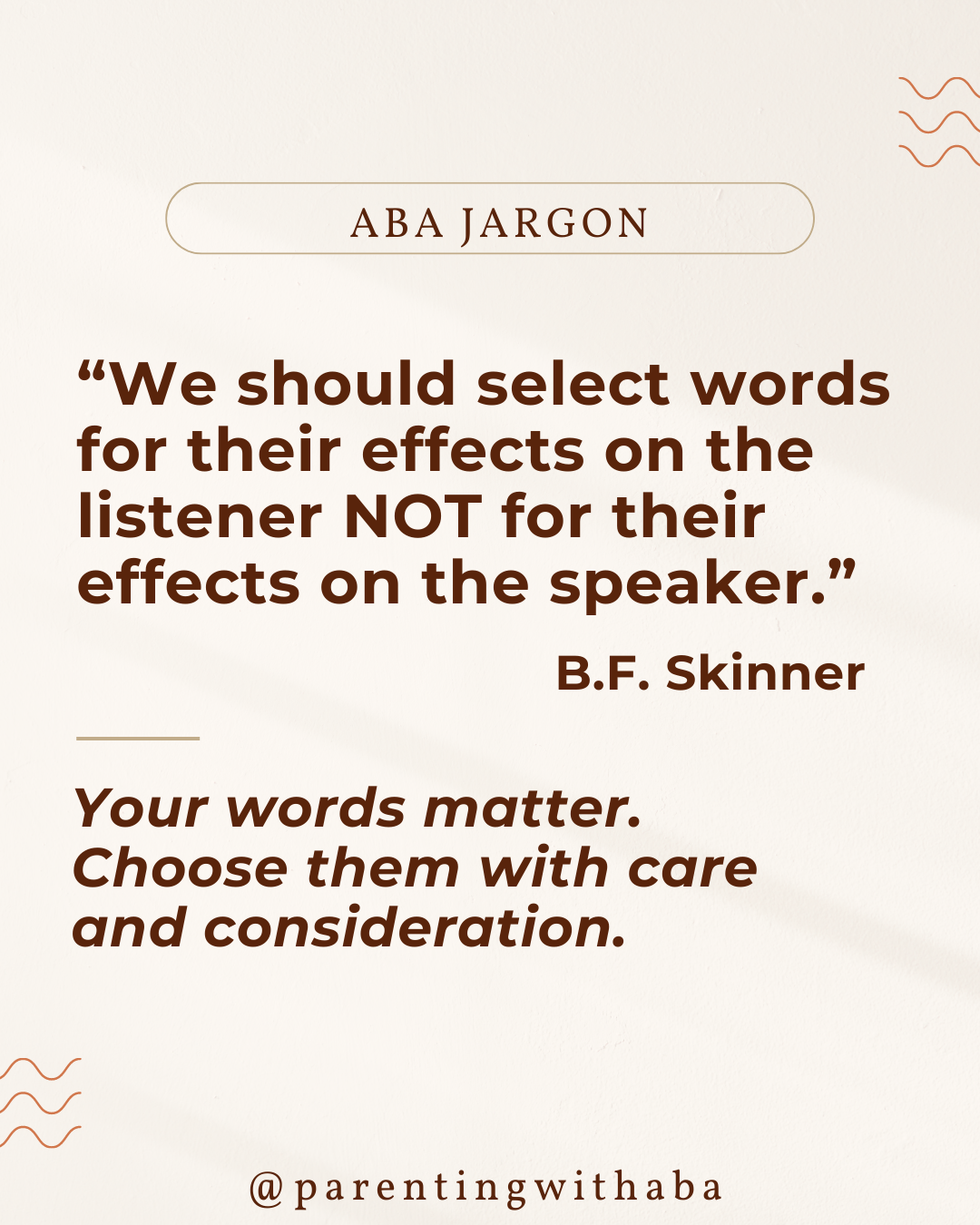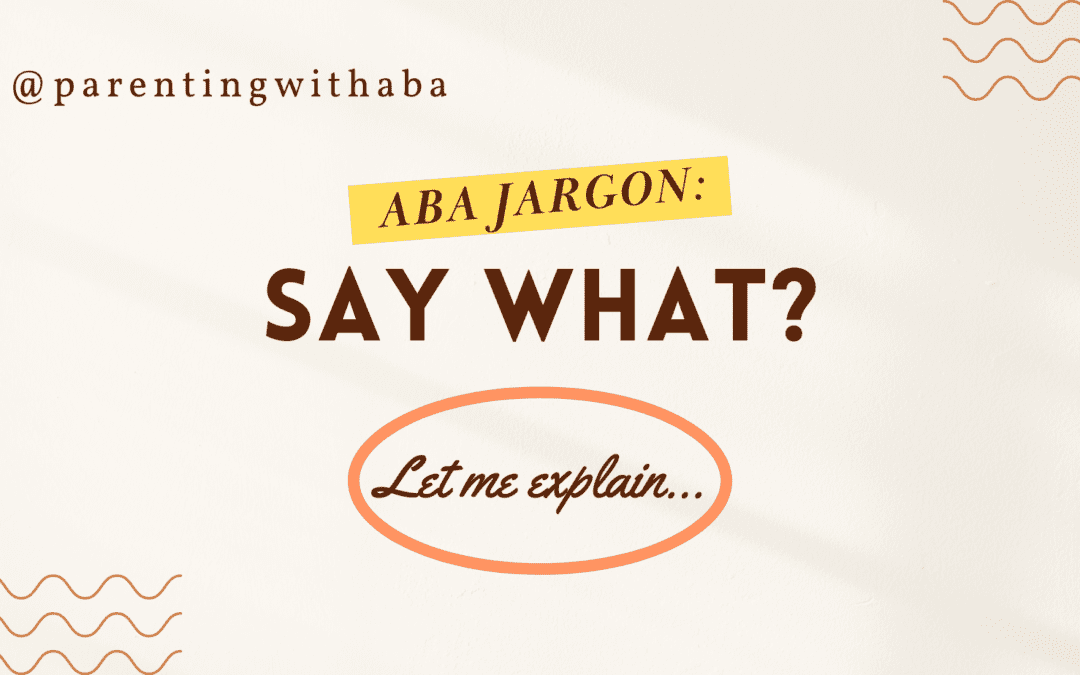
There’s a reason behavior science has all these nerdy behavior terms. But if you are a parent just trying to do what’s best for your child, you really just want to know what is what!
As behavior analysts, we can use both the nerdy term as well as the real-life examples and definitions of it.
In both of my books, you’ll find technical terminology, but you’ll find them also full of examples and practical applications of HOW to use these things to save your sanity and support your child’s growth!
I choose to empower parents and caregivers with the precise, systematic language but only if it’s supported by a ton of examples that make sense and are easy to follow.
If you are a behavior analyst, what words are you using to communicate with parents, teachers, community members? Are you scaring people away with too much jargon? Are you being imprecise by never using jargon at all? It’s a balancing act for sure.
Behaviorspeak or behaviorese is great if you are in a graduate program or a meeting of only behavior analysts. The rest of the world would like to understand what on earth you mean with these specific words, though. – Break them down, please!
I love this quote by Brene Brown (whom I’m a big fan of!):
“Clear is kind. Unclear is unkind.”
Let’s be clear in our behaviorspeak.
Let’s be clear in our behaviorese.
Let’s be clear to save everyone some effort and time in trying to figure out what’s going on here!

Sometimes using both the technical jargon and the everyday wording can feel like translating two languages. It may feel like code switching constantly on the fly. The good news is that it does get easier with practice- just like learning other languages. So get out there are practice!
You can find a whole glossary of ABA terms on my website here for professionals: Parenting with ABA Glossary for Professionals
…And here for parents: Parenting with ABA Glossary for Parents

Words matter.
ABA researchers have looked at the effect of jargon terms completely isolated as stand-alone terms. You can also find published research on how people find these terms within a context/ a scenario. But at the end of the day what do both types of researchers agree on? That the words you choose matter. Choose your words with clarity and kindness.
“We should select words for their effects on the listener NOT for their effects on the speaker.”
-B.F. Skinner
Let’s look at some common behavior science or applied behavior analysis terms and what they mean in less nerdy language.
As you are reading, here are my questions for you:
- Behavior analysts- How would you rewrite any of these definitions? How do you explain these terms?
- Parents- Have you been on the receiving end of jargon speak? How did it make you feel to be talked to in behaviorese?
1. ABA = Applied Behavior Analysis
This acronym simply means using the science of behavior- applying it to socially significant behaviors!
ABA is an umbrella term that can cover many specific and unique strategies that are all backed up by this science of behavior.
ABA is both data-driven and evidence-based.
2. Behavior = Anything we say or do.
Technically most BCBAs will say this has to be observable or measurable. But you can also have private behavior which includes your thoughts and feelings.
The Dead Man’s Test says that if a dead man can do it then it’s not a behavior. Not talking? A dead man can do it. Not hitting? A dead man can do that, too.
Behavior typically involves an interaction with the environment. If you say or do something- it puts a new statement or motion into the environment around you.
3. FBA = Functional Behavior Assessment = Figuring out the why behind a behavior.
A behavior analyst will take ABC data (antecedent- behavior- consequence) or do an assessment called a functional analysis to figure out WHY a behavior is occurring. This is called the function.
If a child is engaging in a problem behavior, we want to replace that with a more appropriate behavior or way of communicating. But the only way this works for a child is if it serves the same purpose, meets the same need, has the same function.
4. Negative reinforcement = Increasing a behavior by stopping something unpleasant.
This term gets confused by ABA people and parents alike! It does NOT mean a negative consequence.
Reinforcement means the behavior increases. Negative means subtract or take away.
The easiest way to explain: when your car makes a beeping sound until you put your seat belt on. The beeping sound negatively reinforced you wearing a seatbelt. Negative because you stopped or subtracted the beeping sound. Reinforcement because your behavior of seat belt wearing increased.
It’s unnecessarily confusing terminology. I’m sorry.
5. Positive reinforcement = Something is added after a behavior & then that behavior happens more often in the future.
By definition, positive reinforcement occurs when something is presented immediately following a behavior and as a result, that behavior occurs more often in the future.
Behavior –> Something is added –> Behavior occurs more often in the future
Are rewards positive reinforcement? Only if they work to increase the behaviors you want to see more of.
Example: Your child tries all the food on their plate at dinner. You give lots of praise and attention. The next night, they try all their food again!
6. Shaping = Using positive reinforcement to build up baby steps toward the goal.
As one baby step is mastered, you raise the bar to the next step. You stop reinforcing the mastered baby step and move on to the next one to gradually teach a new behavior or skill.
This is used to teach a new skill that is too far out of reach to begin with.
Help them get there gradually by raising the expectation when they are ready.
In jargon terms, this is called reinforcing successive approximations to the target behavior. Successive approximations are the baby steps (in order) to the big picture behavior goal.
7. Task analysis = Break down any routine or skill to the most simple steps.
Breaking things down into baby steps and then teaching those baby steps in order can help learn new skills or complete a routine.
Break down any routine or activity to the most simple steps you can think of. Put those in order, list them out, and then either use pictures or words.
We teach each step and can use the list of steps as a visual cue or prompt.
A task analysis is a step-by-step list of actions necessary to complete a specific behavior.
8. Behavior Skills Training (or BST) = A whole package deal of 4 steps to teach a skill.
It puts together several research-based practices to pack the best punch. BST is a research-based strategy to teach new skills. It has been defined as “a procedure consisting of instruction, modeling, behavioral rehearsal, and feedback that is used to teach new behaviors or skills” (Miltenberger, 2004).
There are 4 steps to BST. When using this strategy, you can’t leave out any of these steps. Do all of them. And do them in order, please.
- Instructions: tell them.
- Modeling: show them.
- Rehearsal: have them show you.
- Feedback: praise or prompting
9. Fading = Slowly backing off supports
A behavior analyst’s goal is always for the learner to do new skills independently. It may take a lot of supports like prompts and visuals and chaining and all kinds of behavior tools you can find in Parenting with ABA’s Terms Glossary for Parents and Professionals.
Fading is the systematic or purposeful removal of these supports- slowly, gradually, at a pace that works for the learner to keep being successful and do things independently.
10. Automatic reinforcement = A behavior that is maintained on it’s own and doesn’t require someone to deliver a reinforcer to you = It feels good.
Some things just feel good or are reinforcing without anyone else having to give an external reinforcer.
Your own behavior produces reinforcement.

Recent Comments